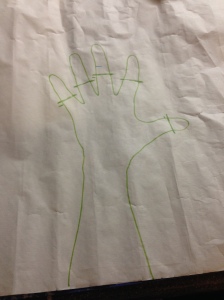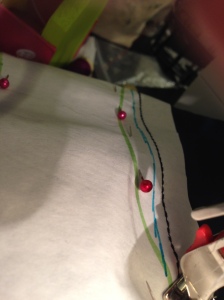A common complaint I hear from cosplayers is how much they hate making gloves! I struggled with them in my younger days, then I discovered this tutorial. I've explained my method to people several times, and since the blog the original tutorial is on has been dormant for a while now, I figured I would write up my own tutorial!
The two secrets to making easy gloves: stretch fabrics and freezer paper.
If this tutorial looks too lengthy to be easy, I promise you it is very simple - I just do my best to go into a lot of detail to help you as much as possible! :)
YOU WILL NEED:
- 4 way stretch fabric in the color of your choice: This tutorial will not work with non-stretch fabrics. You can use spandex, 4-way stretch vinyl, lycra, whatever. If your gloves need to match the color of another part of your costume that is not made from stretch fabric, just find a knit fabric that matches the color and use that. If, like me, you live where good stretch fabrics aren't easy to find, you can order swatches online and see how they match your non-stretch fabric. I recommend SpandexWorld. (The downside to this is that you generally can't purchase less than a yard online, and SW's shipping and prices are not the cheapest... but their spandex is good quality, and I'd rather have extra spandex and a little less money than make gusseted gloves any day.)
- freezer paper: You can find this at any grocery store, usually with the plastic wrap and aluminum foil. (Wax paper is NOT the same thing and will not work!) When heated, the shiny side of freezer paper adheres to fabric and peels away easily without leaving any residue behind. The tutorial I linked uses stabilizer, which you can buy at the fabric store, but freezer paper is MASSIVELY cheaper (a $5 roll will last through many pairs of gloves!).
- a marker: pens and pencils will poke through the freezer paper, so use something with a felt tip.
- a sewing machine with a stretch or zig zag stitch: Your machine may or may not have a stitch specifically for stretch fabrics, but it almost certainly has a zig zag stitch. There are a few varieties of stretch stitches and you will need to check your manual to see which your machine has. If not, a short and narrow zig zag stitch will do. A regular straight stitch will NOT stretch with the fabric and will easily rip out, so it is VERY important to use a proper stitch!
> I prefer the straight stretch stitch (also called the chain stitch) over a zig zag, and there are a couple of reasons for this. The first is that if you use a zig zag or a similar kind of stitch (like a serger/overlock stitch), you can actually see the stitches on the outside of the finished garment - this is not a huge deal especially if you use a thread that matches well and avoid too many close-ups. However, the chain stitch produces a much neater product, so if you are entering a competition or, like me, just aren't satisfied with the "as long as it looks good from 5 feet away" rule, I recommend using it. The other reason is that the chain stitch allows you to cut off the most excess fabric on gloves, resulting in a sleeker, less bulky fit. Even with a narrow zig zag, you can only cut as close as the edge of the zig zag, but with a straight chain stitch you can cut even closer.
I promise I sewed both of these with red thread. I hear you saying “But Lulu, I don’t see any stitching in the second photo!” and I say to you, EXACTLY.
> HOWEVER… it doesn't hurt to sew your pieces together with a zig zag stitch first. Why? The zig zag is much easier to rip out than the chain stitch, so if you are new to this technique or stretch fabrics in general, use a zig zag first to test the fit of your garment, then stretch stitch when you are ready to make things final. If your machine doesn't have a stretch stitch, you'll be using a zig zag anyway, so you can make modifications more easily. A chain stitch is a little bit unwieldy as it goes back and forth back and forth instead of going straight ahead, so if you're not used to using it, use just the zig zag or zig zag first, then chain stitch next to it for the final stitch.
- ballpoint or stretch sewing machine needles: These are readily available at Joann's so as long as you have one of those nearby you can find these without issue. You *can* sew stretch with regular needles, but these kinds of needles are specially made to push knit fibers aside instead of punching a hole through them, reducing the risk of runs and tears. I've only ever used ballpoint and never had an issue, but I hear for others they cause skipped stitches, and stretch needles solve that problem.
- an iron: Cosplayers, freezer paper, and this tutorial are useless without an iron.
- straight pins: Surely you already have some lying around.
- nylon or polyester thread in a matching color: Whatever thread you already have is probably one or the other, so you're good to go.
- scissors: duh
- fabric glue: This is somewhat optional, but you can dab this on the stitches (especially between the fingers) to reinforce them.
LET'S DO THIS!
1. Roll out your freezer paper, shiny side down, and lay your hand flat, like you're about to draw a hand turkey - 'cause that's exactly what you'll be doing. If you are making short gloves, include a couple inches of arm/wrist just so the glove doesn't end up being too short. If your gloves are supposed to have cuffs on them, make sure your pattern is long enough to account for them.
Use your marker to trace your hand turkey. Repeat for the other hand. (You could draw on a small (and I do mean small!!) amount of seam allowance here, but I do things differently - read on and see if my method works for you.)
This pattern was actually made for my Lucina gloves, which are fingerless and have cuffs. I marked the pattern just above my knuckles and made them extra long to account for the cuffs.
If you're anything like me you'll draw the wrist opening too small, so use your marker to widen the lines around the wrist a little bit - this will make the gloves easier to pull on in the end.
2. Cut around your hand turkeys, leaving at least half an inch around the line you just drew. Now is a good time to plug in your iron. Be smart about how high a heat setting you use - the freezer paper can stand up to a pretty high heat but your fabric may not, so use a medium setting just in case your iron runs onto the fabric. (As with any fabric you use, doing a heat test on a spare scrap is a good idea, and yes, I have melted spandex before.)
3. This is where the magic happens. Fold your fabric in half, place your hand turkey on top, and iron it down.
The bowl is there to keep the freezer paper in place since it likes to roll up on itself… not for anything special. :P
Pin through the freezer paper and both layers of fabric, inside the line of your hand turkey.
Cut the fabric around your freezer paper and head to your sewing machine. I keep my iron on just in case the freezer paper comes loose, but it shouldn't.
4. Set up your machine with the proper thread and needles, and pick your stitch. I actually stitch just outside my line (with my needle placed slightly to the right) to give a little bit of seam allowance. (If you are using a zig zag, line up your presser foot just outside the line.)
Needle set a couple notches right of center…
BOOM. Instant seam allowance!
This gives you a little extra wiggle room without the gloves being too tight or too loose. I've never had to draw seam allowance on my glove patterns with this method! Check out this video on my Instagram to see it in action.
5. Start sewing! This is definitely a test of how much control you have over your machine. If you’re not comfortable sewing curves, angles and corners, this will be a little tougher for you, so go slow (use your machine’s speed options if it has them) and practice with a zig zag stitch (it’s easier to control than the straight stretch). If it’s not perfectly beautiful, don’t worry - the best thing about stretch fabrics is that they're pretty forgiving when it comes to uneven stitching.
When you get to the narrow areas just between the fingers, sew in a U or box shape, not a V shape. The V shape causes ugly puckers in the final product, but a U or box shape makes things nice and smooth when you turn your glove inside out. As you get close to the areas between the fingers, taper your seam allowance closer to the drawn line.
Okay in hindsight this is kind of a shitty example. I did not sew this slowly.
BUT IT STILL LOOKS NICE IN THE END. thanx stretch
6. Before you cut off the excess fabric, you can slide your hand inside and test the fit (again, refer to my Instagram video). If anything is too loose or too tight, this is the time to fix it. (This will likely cause the freezer paper to tear but you're almost done with it at this point.)
If you're happy with the fit, CAREFULLY trim the fabric as close to your stitching as possible, then turn inside out. If you are sewing a darker fabric, it does help to leave the freezer paper on so you can more easily see the line of stitches (and therefore not cut right through them).
7. If you have a cuff to add to your glove, now is the time to do that and finish off the whole thing. If you don't, simply turn the excess fabric in at the wrist (trim it down first if you have too much excess) and top stitch (using your same stretch-friendly stitch!). Wiggle your fingers happily because you are now done!
PICTURED: not the same gloves I was making when I took the photos for this tutorial.
If you have questions, please leave them using the question box on my Cospix profile, or you can always contact me on Facebook and Twitter! If you found this tutorial helpful, please tag it to your Cospix costumes! It's also in rebloggable form on Tumblr and Wordpress.
Here are the costumes that include gloves I've made using this method:
Sheryl Nome (Lion) - gloves made with purple spandex so they matched my (also custom made) stockings!
Hanayo Koizumi (Snow Halation)/Soni-Claus - gloves made with cotton knit from my stash (I had more time than money when finishing this costume, so I opted to make instead of buy)
Battle Bunny Riven - yes, this even helped me make my fuzzy bunny glove for Riven!
Tiki - I specifically chose a knit fabric for Tiki so that the dress, gloves, and boot covers would all match. The cuffs are made from interfaced peachskin.
Lucina - These are the gloves I made for this tutorial!









